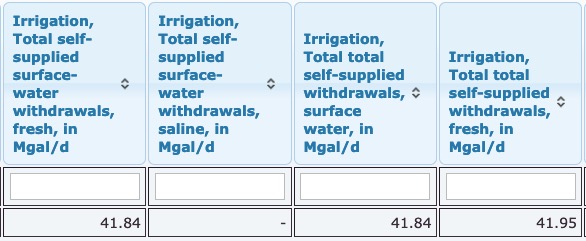Despite the rising death toll and economic turmoil caused by the 2020 COVID pandemic, many people probably may still hold the belief that the population of the United States, and of the state of Colorado, and of Pagosa Springs, will grow, indefinitely.
At the same time, many people involved in the provision of water resources worry that the American West may be headed into an extended period of drought due to climatic changes, and that we need to address this impending water shortage by taking action — now, before it’s too late.
Just what those actions should be, is the subject of considerable debate.
The folks most dependent upon generous water supplies, in the American West, work in agriculture. The amount of water required by agricultural interests far outstrips all other uses combined. But most Americans are not directly involved in agricultural production, other than as consumers. For most of us, ‘water’ is something we use to irrigate the lawn, provide a hot shower in the morning, and brew our coffee. We don’t often stop to consider, for example, that it takes 1,800 gallons of water to produce one pound of beef.
As mentioned in Part One, I’m one of the volunteer board members serving the tax-supported San Juan Water Conservancy District, and while working on the District’s draft ‘Strategic Plan’ over the past several months, I came across a website maintained by the US Geological Survey (USGS), a government organization that provides data about — among other things — water availability and usage.
You can view some of their Colorado data here.
We understand that ‘data’ is not the same as ‘facts.’ That much has become abundantly clear during this coronavirus pandemic, with ever-changing data coming from various (reliable, and unreliable) sources. But data can sometimes be useful… even data produced by government agencies… so long as we don’t assume it’s 100% accurate.
According to USGS data for Archuleta County, about 8,590 people were served by “public” water supplies in 2015, utilized at a rate of about 2.44 million gallons per day, which comes to about 890 million gallons used that year. (This number comes from the ‘Public Supply’ table of data on the USGS website.)
Other uses of water tracked by USGS include mining, industrial, livestock, and of course, agricultural.
Under the “Irrigation” tab, we can find the amount of water that USGS believes was used for that purpose in Archuleta County, in 2015.

41.95 million gallon per day. About 15.3 billion gallons per year.
If these government numbers are accurate, then the folks engaged in “Irrigation” in Archuleta County utilize quite a bit more of our local water resources than do the folks who are not engaged in agriculture. Mining, commercial industry, and livestock watering also use relatively minor amounts of local water, but ordinary residential water use is where many people look for evidence of ‘water conservation.’
It would appear that “Irrigation” accounts for about 94 percent of all water utilized in Archuleta County. If ‘water conservation’ is a meaningful goal, then we obviously need to look to agriculture for meaningful solutions.
The picture is of course more complicated, because some water uses — like, say, flushing a toilet or taking a shower — do not permanently remove water from the surface water supply, because the water goes back into the river after a treatment process. Irrigating a field of alfalfa, on the other hand, does not necessarily return water to accessible surface water supplies. Some is absorbed by the crop, some evaporates into the air, and some sinks into the ground to join underwater aquifers. Which is to say, an agricultural use might remove considerably more water from the system than does a typical residential use.
Colorado regulates access to water through the Colorado Water Law. The rules are many and varied, but the backbone of the law rests on the principal of ‘prior appropriation.’ If a water user successfully applies for a water right, and then successfully puts the water to a ‘beneficial use,’ that water use is considered ‘appropriated’ and cannot be threatened by another water user who comes along later… so long as the first user continues to use the water as intended.
If water remains available after all appropriated uses have been satisfied, the remaining water can be used by anyone, whether they have water rights of not.
From the Colorado Constitution, Article XVI:
§ 5. Water of streams public property. The water of every natural stream, not heretofore appropriated, within the state of Colorado, is hereby declared to be the property of the public, and the same is dedicated to the use of the people of the state, subject to appropriation as hereinafter provided.
§ 6. Diverting unappropriated water… The right to divert the unappropriated waters of any natural stream to beneficial uses shall never be denied…
This doctrine dates back to the 1860, when nearly all commercial enterprises in Colorado were engaged in either agriculture or mining. Thus, nearly all of the most senior water rights in Archuleta County — the appropriated water rights that take priority in cases of water shortages — belong to agricultural users, or to organizations that purchased agricultural land from farmers or ranchers.
Food, water, clothing and shelter are all highly valued by city dwellers — even if we sometimes forget that someone had to grow the potatoes and raise the chickens and pick the cotton and harvest the timber, and that most of our food and beverages are highly dependent upon the availability of water.
But when our basic water law dates back to the 1860s, and hasn’t substantially changed since…?
Well, folks in the towns and cities might find themselves paying an awful lot of money, for a relatively small helping of the available water.

